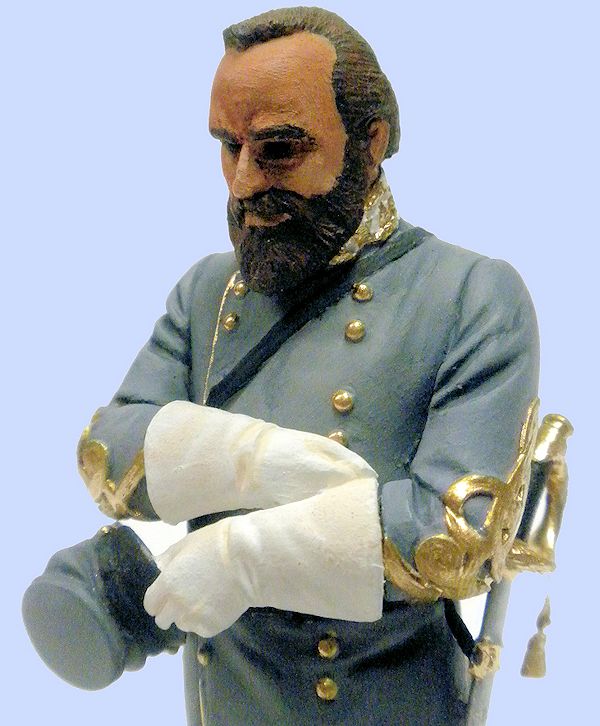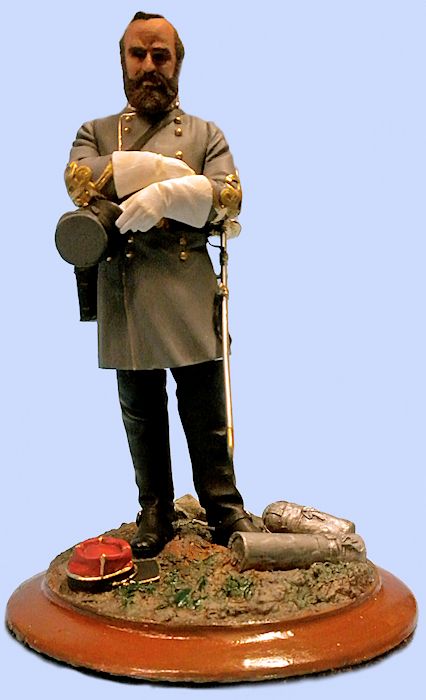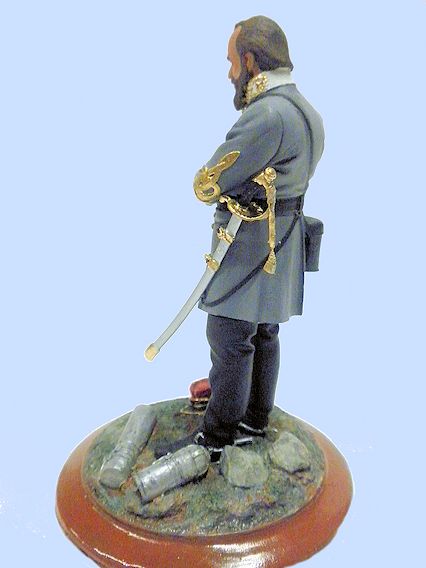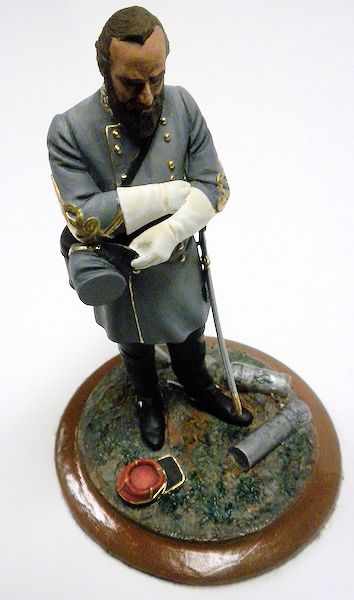
Verlinden 120MM (1/16) Stonewall Jackson Figure
| KIT #: | 1254 |
| PRICE: | $29.95 |
| DECALS: | N/A |
| REVIEWER: | Blair Stewart |
| NOTES: | Resin figure |

| HISTORY |
Thomas Jonathan “Stonewall” Jackson is one of the greatest
soldiers America has ever produced. His
tactical exploits as a Confederate general during the Civil War are legendary,
and some military historians believe that, had he not been accidentally killed
by his own men at the Battle of Chancellorsville, there may well have been a
different outcome to the battle of Gettysburg, and perhaps the war.
Jackson was one of the best-known Confederate commanders
after General Robert E. Lee. Highlights of his military career include the
Valley Campaign of 1862 and his service as a corps commander in the Army of
Northern Virginia under Lee. Unfortunately for the South, Confederate pickets
accidentally shot Jackson at the Battle of Chancellorsville on May 2, 1863.
Jackson survived with the loss of an arm to amputation, but died of
complications from pneumonia eight days later. His death was a severe setback
for the Confederacy; affecting not only its military prospects, but also the
morale of its army and of the general public.
Military historians consider Jackson to be one of the most
gifted tactical commanders in U.S. history. His Valley Campaign and his flanking
envelopment of the Union Army’s right wing at Chancellorsville are still studied
worldwide as examples of innovative and bold leadership. He excelled as well in
other battles: the First Battle of Bull Run (First Manassas), where he received
his famous nickname "Stonewall"; Second Bull Run (Second Manassas); Antietam;
and Fredericksburg.
An 1846 graduate of the US Military Academy (West Point),
Jackson began his United States Army career as a second lieutenant in the 1st
U.S. Artillery Regiment and was sent to fight in the Mexican–American War. His
campaigns during that war included the Siege of Veracruz and the battles of
Contreras,  Chapultepec,
and Mexico City. He eventually earned two brevet promotions and the regular army
rank of first lieutenant. It was in Mexico that Thomas Jackson first met Robert
E. Lee.
Chapultepec,
and Mexico City. He eventually earned two brevet promotions and the regular army
rank of first lieutenant. It was in Mexico that Thomas Jackson first met Robert
E. Lee.
In 1851 Jackson accepted a newly created teaching position at
the Virginia Military Institute (VMI), in Lexington, Virginia, where he become
Professor of Natural and Experimental Philosophy and Instructor of Artillery.
VMI still teaches some of of Jackson's curriculum, which are regarded as
timeless military essentials, including: discipline; mobility; assessing the
enemy's strength and intentions while attempting to conceal your own; and the
efficiency of artillery combined with an infantry assault.
By the start of the Civil War in April of 1861, Jackson had
reached the rank of colonel. After his promotion to brigadier general in early
July, Jackson rose to prominence and earned his famous nickname as a brigade
commander at the First Battle of Bull Run (First Manassas) on July 21, 1861. As
the Confederate lines began to crumble under heavy Union assault, Jackson's
brigade provided crucial reinforcements on Henry House Hill, demonstrating the
discipline he had instilled in his men. Brig. Gen. Barnard Elliott Bee, Jr.,
exhorted his own troops to re-form by shouting, "There is Jackson standing like
a stone wall. Let us determine to die here, and we will conquer. Follow me!"
General Bee would later be killed at Bull Run, but he had given the South not
only his life but also the most famous nickname in American military history.
In the spring of 1862, the Union Army chose to make Richmond,
VA its primary objective instead of the enemy’s armed forces. As of what became
known as the Peninsula Campaign, Maj. Gen. George B. McClellan's Army of the
Potomac approached Richmond from the southeast, Maj. Gen. Irvin McDowell's corps
was aiming to hit Richmond from the north, and Maj. Gen. Nathaniel P. Banks's
army threatened the Shenandoah Valley. Confederate authorities in Richmond
ordered Jackson to operate in the Valley to defeat Banks' threat and prevent
McDowell's troops from reinforcing McClellan.
Jackson’s Valley Campaign started with a tactical defeat at
Kernstown on March 23, 1862, when faulty intelligence led him to believe he was
attacking a small detachment. But it became a strategic victory for the
Confederacy, because his aggressiveness and great audacity suggested that he
commanded a much larger force than his small division of 10-17,000 men.
These victories ultimately convinced
President Abraham Lincoln to keep Banks' troops in the Valley and McDowell's
30,000-man corps near Fredericksburg. In the end, these deployments subtracted
about 50,000 soldiers from McClellan's Richmond invasion force.
Although significantly outnumbered, Jackson was able to
attack and defeat portions of his enemy’s divided force, defeating both Brig.
Gens. Robert H. Milroy and Robert C. Schenck. He then defeated Banks at Front
Royal and Winchester, ejecting him from the Valley.
Lincoln then decided that the defeat of Jackson was an
immediate priority (though Jackson's orders were solely to keep Union forces
occupied and away from Richmond). He ordered Gen. McDowell to send 20,000 men to
Front Royal and Maj. Gen. John C. Frémont to move to Harrisonburg. If both
forces could converge at Strasburg, Jackson's only escape route up the Valley
would be cut.
 After a
series of maneuvers, Jackson defeated Frémont's command at Cross Keys and Brig.
Gen. James Shields at Port Republic on June 8–9. Union forces were then
withdrawn from the Valley.
After a
series of maneuvers, Jackson defeated Frémont's command at Cross Keys and Brig.
Gen. James Shields at Port Republic on June 8–9. Union forces were then
withdrawn from the Valley.
The valley was a classic military campaign of surprise and
maneuver. Jackson pressed his army to travel 646 miles in 48 days of marching
and won five significant victories with a force of about 17,000 against a
combined force of 60,000. Stonewall Jackson's reputation for moving his troops
so rapidly earned his soldiers the nickname "foot cavalry". As a result of the
campaign, Jackson became the most celebrated soldier in the Confederacy (until
he was later eclipsed by Lee) and lifted the morale of the Southern public.
At the Battle of Chancellorsville, the Army of Northern
Virginia faced a serious threat from the Army of the Potomac and its new
commanding general, Major General Joseph Hooker. General Lee decided to use a
risky tactic to take the initiative and offensive away from Hooker's new
southern assault: he decided to divide his forces. Lee sent Jackson and his
entire corps on an aggressive flanking maneuver to the right of the Union lines.
This flanking movement would be one of the most successful and dramatic
maneuvers of the war.
Lee’s divided force plan was simple but very risky. Jackson
would lead his Second Corps of 28,000 men in a bold maneuver to attack the Union
right flank while Lee exercised personal command of the remaining two divisions,
about 13,000 men and 24 guns facing the 70,000 Union troops at Chancellorsville.
For the plan to work, several things had to happen. First, Jackson had to make a
12-mile forced march across the enemy’s battle line, using roundabout roads to
reach the Union right, and he had to do it undetected (a similar tactic used in
modern times by the US XVIII Airborne Corps during the ground phase of Operation
Desert Storm). Second, Hooker had to stay tamely on the defensive. Third,
Confederate Maj. Gen. Jubal A. Early would have to keep the Union Army’s VI
Corps under Maj. Gen. John Sedgwick tied up at Fredericksburg, despite the
four-to-one Union advantage there. And when Jackson launched his attack, he had
to hope that the Union forces were not prepared for or suspecting an attack.
While riding with his infantry in a wide berth well south and
west of the Union battle line, Jackson used Maj. Gen. Fitzhugh Lee's cavalry to
provide reconnaissance as to the exact location of the Union right and rear. The
results were far better than Jackson could have hoped. Fitzhugh Lee found the
entire right side of the Union line in the middle of an open field, guarded by
only two artillery pieces that faced westward. The Union soldiers were eating
and playing games, completely unaware that an entire Confederate corps was less
than a mile away.
Jackson immediately returned to his corps and arranged his
divisions into a line of battle to charge directly into the oblivious Federal
right. The Confederates marched silently until they were only several
 hundred feet
from the Union position, and then released a bloodthirsty cry and full charge.
Many of the Union soliders were captured without a shot being fired, and the
rest were driven into a full rout. Jackson pushed his force relentlessly back
toward the center of the Union line until dusk.
hundred feet
from the Union position, and then released a bloodthirsty cry and full charge.
Many of the Union soliders were captured without a shot being fired, and the
rest were driven into a full rout. Jackson pushed his force relentlessly back
toward the center of the Union line until dusk.
After darkness ended the assault, Jackson and his staff
decided to reconnoiter the location and strength of the now makeshift Union
line. Returning to camp, they came within range of the 18th North
Carolina infantry, who saw only horsemen approaching in a menacing way from the
direction of the Union lines. The understandably nervous troops opened fire on
Jackson’s party. Three .57 caliber bullets struck Jackson simultaneously: two in
his left arm and one through his right palm.
The firing killed several of Jackson’s staff as well as many
horses. Darkness and confusion prevented Jackson from getting immediate medical
care. Confederate stretcher bearers dropped him while evacuating him in reaction
to incoming artillery rounds. Eventually, Dr. Hunter McGuire had to amputate
Jackson's left arm. Jackson was then
moved to Thomas C. Chandler's plantation named Fairfield. He was offered
Chandler's home for recovery, but Jackson refused and suggested using Chandler's
plantation office building instead. His doctors thought he was out of harm's
way; but unknown to them, he already had the symptoms of pneumonia, as he
complained of a sore chest. The doctors mistakenly took this soreness to be the
result of his rough handling during the evacuation from the battlefield.
Jackson died of complications from pneumonia on May 10, 1863. His last words were: "Let us cross over the river, and rest under the shade of the trees."
| THE KIT |
Since the late seventies, Verlinden
Productions has been a leader in the sculpting and production of
aftermarket parts and resin figures. Their line of resin 120mm (1/16th
scale) figures includes a number of works depicting famous military leaders such
as Napoleon, the Duke of Wellington, Jeb Stuart, Robert E. Lee, Ulysses S.
Grant, Norman Swartzkopf and others. Among their 120mm figures is a highly
detailed  rendition
of Stonewall Jackson. Jackson is depicted with folded arms on a battlefield,
contemplating the situation (or perhaps his next tactical move).
rendition
of Stonewall Jackson. Jackson is depicted with folded arms on a battlefield,
contemplating the situation (or perhaps his next tactical move).
Like most of these figures, the Verlinden Stonewall
Jackson comes in several separate parts and some smaller parts attached to resin
casting blocks. The head, arms, torso and legs are separate components, as are
the general’s individual pieces of equipment. The sculpting of the figure
is extremely sharp with the great detail afforded by the large 120mm scale.
The kit consists of 15 resin pieces and a piece of plain
paper that is used to construct various straps for the figure’s saber.
The model includes equipment such as Jackson’s Kepi field cap, which he
preferred over more elaborate, brimmed hats worn by most Civil War general
officers, a well molded saber and scabbard, a field glasses case, spurs, saber
strap rings, and riding gloves. A particular plus is the inclusion of a detailed
resin base, which has rocks, ground cover and a variety of battlefield debris
molded onto it. The “extra” plus of this base is that one can paint it to
resemble a wooden display base, thereby negating the need to find a wooden one,
stain it, finish it, and then glue the figure to it.
This is my third Verlinden 120mm kit, having assembled and painted Jeb Stuart - kit # 1470 - and Kit # 628, US Army SAW Gunner, which I previously reviewed here on Modeling Madness. These are outstanding kits, and the detail is quite amazing. As usual with resin kits, the biggest challenge is cutting the various pieces from their casting blocks without damaging or breaking them, particularly the smaller ones (e.g., spurs, saber tassel, saber strap rings).
| CONSTRUCTION |
Once I did this, I used Super Glue to assemble the torso,
legs and head and arms. When these were dry, I glued the figure to a wooden
paint stirring stick to facilitate handling the model.
I then spray painted the figure with Testors flat white ename l
to serve as the base coat and provide a light base for subsequent painting.
l
to serve as the base coat and provide a light base for subsequent painting.
The next step was to paint the figure. For this figure, I
primarily used relatively inexpensive acrylic paints available from all sorts of
places such as Michaels. The only other type of paint I used was Testors enamel,
which I used this for the primer coat, the brass, silver and steel components on
the general’s uniform and the base, and the cap that is on the base.
I first started painting the general’s face. I used a darker
shade of flesh tone to facilitate later detailing of the face using lighter and
lighter shades of flesh tones. Since the general is posed in a contemplative
mood, it was not necessary to paint detailed eyes on the figure, as these are
somewhat obscured by the general’s “scowl.”
To get the bluish gray tint of the Confederate uniform, I
mixed my own shade of gray using flat black and white in the trusty “trial and
error” method. Once I was satisfied with the mixed gray shade, I used a
relatively wide hobby brush to paint the general’s uniform coat with this paint.
I then painted the general’s boots flat black. I then moved
to applying details to the figure (e.g., the buttons, braid, collar insignia,
etc.). At this point, I was ready to transfer the figure to the resin base.
After super gluing it to the base, I then painted the base with various dirt and
grass shades, and then highlighted the battlefield debris equipment.
Next came the addition of the saber. As previously mentioned,
the saber strap rings are separate and small, and I broke one of them cutting it
from its resin block. This required me to make a replacement, which I did out of
thin wire. Once the saber was secured to the figure, I cut
thin straps from the piece of paper (any printer paper would work just as
well), attached these to the saber, and then attached them to the equipment
belt. I then painted the Kepi black and gray and glued it to the general’s left
hand.
The final touch was to fashion a tassel strap out of
paper, glue the resin tassel end to it, and then attach it to the saber. I then
finished this with Testors gold enamel paint.
| COLORS AND MARKINGS |
 Again,
with figures, the major challenge is the skin tones, and then the proper shading
to get some kind of expression on the face.
The additional
challenge here was a gray tint that replicates the Confederate gray uniform
color.
Again,
with figures, the major challenge is the skin tones, and then the proper shading
to get some kind of expression on the face.
The additional
challenge here was a gray tint that replicates the Confederate gray uniform
color.
Once I had painted everything, I mixed some more black paint with the gray uniform paint, and then used this to highlight folds in the uniform and the general’s gloves.
Once the figure and base were finished, I painted the outside
of the resin base with a dark brown. When dry, I applied multiple coats of
Testors Glosscote until I got a good clear finish on the base.
| CONCLUSIONS |
This is a great representation of an historic military
figure, and assembling and finishing it was a pleasant break from my normal
routine of plastic armor, aircraft and automobile kits. I highly recommend this
kit to anyone who is interested in figure modeling and has a little experience
with hand painting figures.
| REFERENCES |
Robertson, James
I., Jr. Stonewall Jackson: The Man, The Soldier, The Legend. New York:
MacMillan Publishing, 1997.
Gulf War, Wikipedia, December 2014.
December 2014 If you would like your product reviewed fairly and fairly quickly, please
contact
the editor or see other details in the
Note to
Contributors.